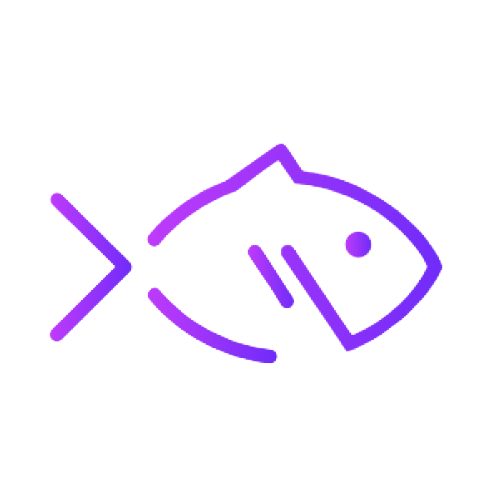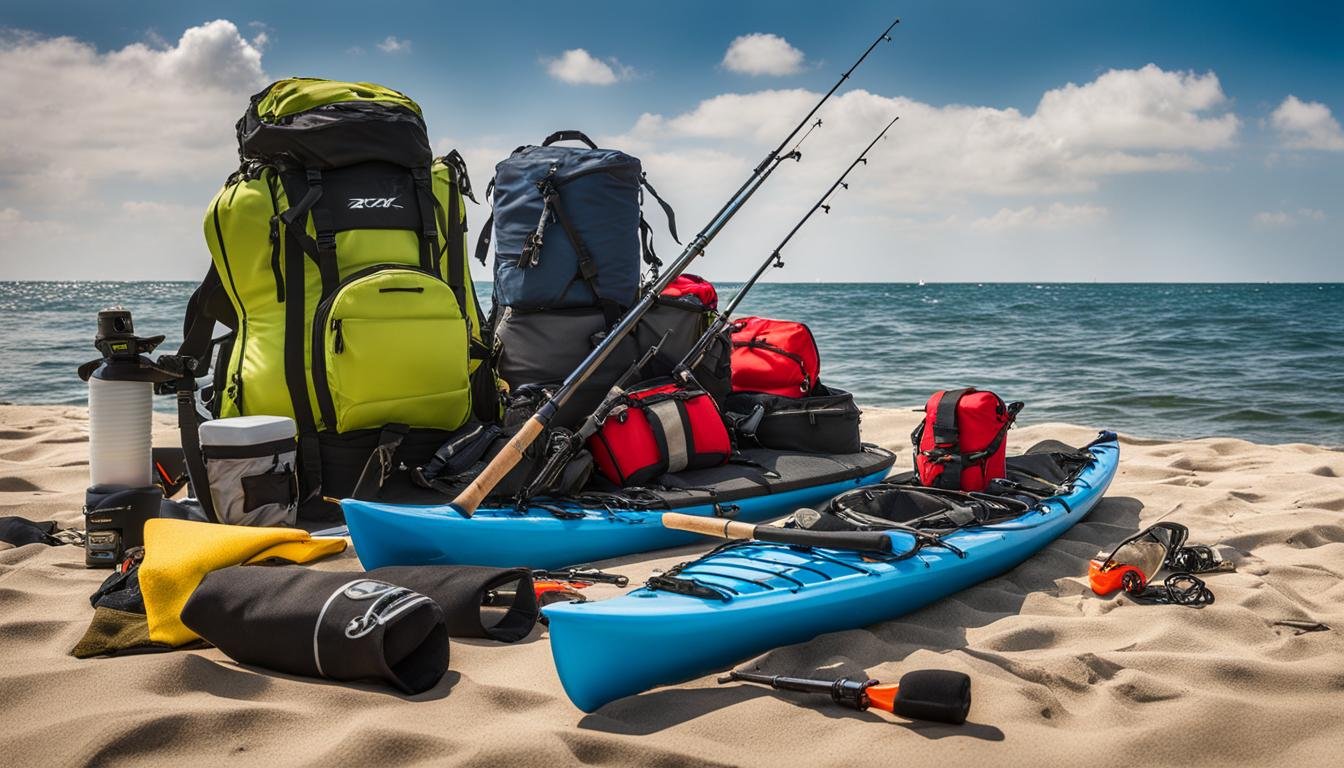As an avid fisherman, I’ve discovered that kayak fishing is more than just a leisure activity; it’s a fusion of adventure and skill that calls to the angler’s spirit. The blend of serene natural landscapes with the anticipation of a big catch creates an unparalleled kayak fishing experience. My tales from fishing trips are as much about the thrill of the catch as they are about mastering angler techniques amidst the lap of waves. In this kayak fishing guide, I’ll share essential insights to elevate your angling pursuits—from choosing the essential gear for fishing to the subtle interplay of paddle strokes and line casts. Join me as I navigate you through the intricacies of this wondrous sport.
Whether you’re mapping out your first fishing trip or looking to refine your casting technique, understanding the nuances of kayak angling is key to reeling in those rewarding moments on the water. Kayak fishing enables you to reach untouched waters and angling hotspots with ease, and with the right knowledge, you can make your journey on the kayak an unforgettable adventure. Let’s drift into the current of kayak fishing together, as I lay out the strategies and secrets that have made my time on the water both mesmeric and bountiful.
Key Takeaways
- Discover the allure of kayak fishing and how it blends the tranquility of nature with the excitement of the catch.
- Learn about the essential gear for fishing to ensure you’re well-prepared for a successful kayak fishing trip.
- Understand the core angler techniques needed to navigate diverse water conditions and attract the biggest fish.
- Gain insights into selecting the ideal kayak that caters to your fishing style and the environments you’ll explore.
- Embrace tips and strategies to create an enriching kayak fishing experience that awards both newcomers and seasoned pros.
Embracing the Kayak Fishing Experience
When I first dipped my paddle into the tranquil waters, I knew kayak fishing would transform how I enjoy the outdoors. Its allure isn’t just about the catch; it’s the voyage—the quiet breaks of dawn, the symphony of water against my hull, and the promise of the unseen beneath the ripples. As a kayak angler, the very essence of nature becomes my companion, inviting me to immerse myself in the raw and beautiful theater of life that unfolds on the water.
My kayak fishing journey has been a tapestry of early mornings and golden sunsets, threaded with the patience of the sport and the excitement of a sudden tug on the line. Unlike larger vessels that keep you separate from the water’s caress, a kayak puts you right at the surface, connecting you with every current and letting you glide stealthily to those clandestine honey holes where fish converge.
Kayak fishing’s inexpensive entry compared to traditional boat fishing makes it a delightful gateway to the aquatic world. The sport doesn’t demand brute strength or the latest in high-tech gear. Instead, it rewards ingenuity and intuition—the artisanal art of kayak fishing. Whether it’s the perfect cast or the cleverly rigged setup, there’s a gratifying simplicity in paring down to the essentials.
- Freedom to explore remote fishing locales
- Intimate connection with the water and environment
- Physical activity that promotes health and well-being
- Affordability, maximizing the experience without maximal expense
On this journey, it’s not just about the fish; it’s about the stories, the lessons, and the quiet, reflective moments amidst nature’s grandeur. I invite you to grab a paddle, set out onto the waters, and join me in this continually unfolding adventure, where every cast nets not only fish but also memories to last a lifetime. Together, let’s explore the art of kayak fishing and find joy in the simple act of casting lines and seeking the thrills that only this form of angling can offer.
The Essential Selection: Choosing Your Fishing Kayak
Embarking on a kayak fishing adventure compels me to share my insights on how to choose a fishing kayak that meets your needs. While the anticipation of a serene day melding with the rhythmic pulse of water is tantalizing, the foundation of an exceptional fishing experience lies in selecting the perfect vessel. There are myriad factors to consider, from the type of kayak—whether sit-on-top or sit-inside—to the propulsion system; a paddle or a cutting-edge pedal kayak. Each feature plays a crucial role in the day’s success.
Stability is paramount on the water, ensuring that you are concentrating on the fish, not on maintaining your balance. Alongside stability, key considerations like storage space and weight capacity determine how much gear I can bring and how well the kayak will handle it. The distinct advantages of a fishing kayak over a standard model are highlighted in the specialized amenities such as elevated seating for better visibility, rod holders for convenience, and additional mounting points to customize the kayak to my fishing regimen.
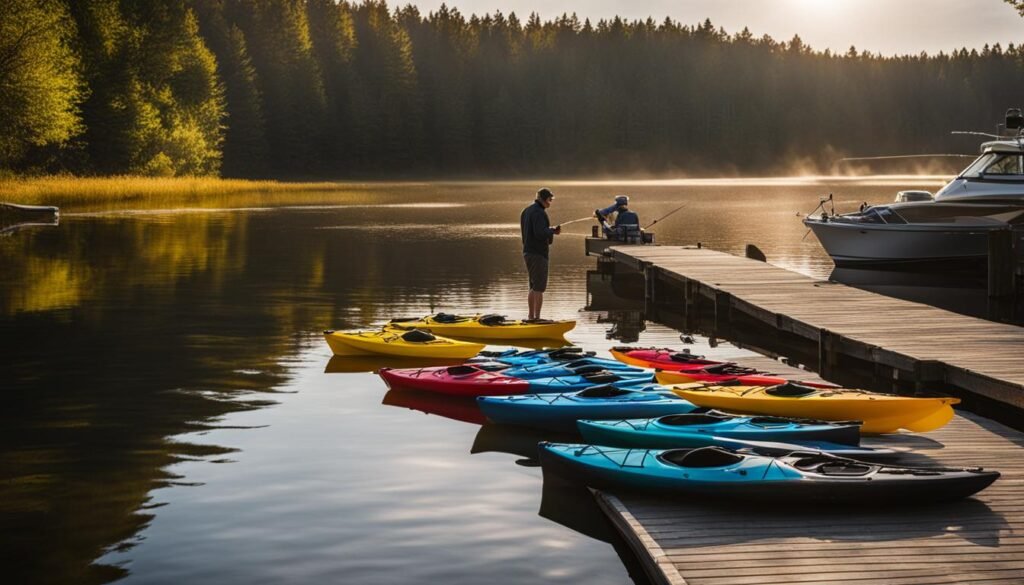
To aid in the decision-making process, I find it useful to compare various models. Let’s examine a few, assessing their strengths and how they align with different angling environments and personal preferences.
| Kayak Model | Type | Stability | Storage | Weight Capacity | Pedal or Paddle |
|---|---|---|---|---|---|
| Adventure Fish 10 | Sit-on-top | High | Dual sealed hatches, rear tankwell | 400 lbs | Paddle |
| Stealth Angler Pro | Sit-on-top | Superior | Center console, side storage pods | 475 lbs | Pedal |
| River Chase 12 | Sit-in | Moderate | Front deck bungees | 350 lbs | Paddle |
I find that each time I venture out, the conditions of the water—be it a calm lake or a bustling coastal inlet—and the chased species profoundly influence my choice of kayak. The sit-on-top models grant me the liberty to cast freely and access my gear with ease. However, in colder climates or when I yearn for a sprightly paddle, the encapsulating cocoon of a sit-in kayak becomes more appealing.
Ultimately, as I choose a fishing kayak, it’s not just about the features; it’s about anticipating the coming together of skill, environment, and equipment to create an effortlessly fluid angling synergy. Whether through the quiet serenity of a paddle or the robust advance of a pedal system, my kayak becomes an extension of my intentions, a vessel for adventure, and a platform for the catch of a lifetime.
Outfitting Your Kayak for Optimal Angling
As I meticulously select my kayak for fishing, the tools and adaptations I incorporate directly influence the efficacy and pleasure of my angling pursuits. Let me walk you through the essentials of outfitting for the best experience on the water. It’s all about having the right fishing gear, tackle box, and clever solutions to maintain efficiency and comfort during long hours of fishing.
Understanding Kayak Gear Specifications
My fervor for kayak fishing compels me to invest in adjustable fishing rods and integrated rod holders, ensuring each piece of equipment enhances my ability to angle with precision. The gear’s specifications greatly matter. While the market is flooded with generic gear, I recommend fishing enthusiasts to look for gear and accessories designed specifically for kayak fishing to elevate the overall experience.
Tailoring Storage Solutions: Rods, Reels, and Tackle
With space at a premium, it’s crucial to optimize every inch of your kayak. A well-organized tackle box and storage compartments for bait and lures are the backbone of any successful fishing trip. I ensure that my gear storage space not only fits my equipment but is also strategically placed for rapid access. As an angler, you’ll appreciate the value of a tidy deck that simultaneously provides all the necessities within arm’s reach.
Integration of Fish Finders and Electronic Aids
In today’s angling scene, there’s an undeniable edge to integrating electronic fishing aids into your setup. The thoughtful placement of fish finder mounts and the inclusion of navigational technology significantly deepen my understanding of the underwater world. This modern approach to fishing technology doesn’t only aid in locating schools of fish; it enriches my connection with the aquatic environment, marrying tradition with innovation for an unparalleled angling experience.
By fusing together the advanced with the traditional, my kayak becomes a vessel that offers not just a journey over water, but into the depths below. It’s this commitment to gear, knowledge, and technique that transforms each excursion into an extraordinary convergence of nature and sport.
Essential Fishing Techniques From a Kayak
The profound silence of kayak fishing is not just about embracing the calm but mastering the ballet of stealth that goes into every maneuver I make. When I settle into my waterborne hideaway, the casting technique I employ often defines the difference between a bountiful day and returning to the shore with a tale of ‘the one that got away.’ It’s in the gentle flick of the wrist, the seamless entry of the lure into the water, and the stealth approach that obfuscates my presence from the watchful eyes of the fish.
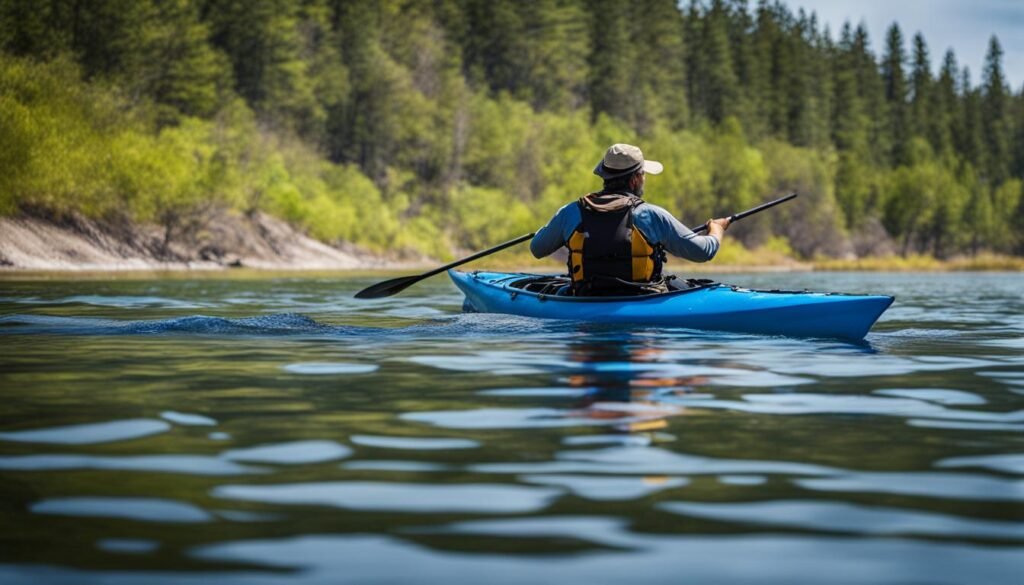
Mastering Stealth and Casting
For me, kayak fishing is a game of quiet pursuit. As I glide across the water, the last thing I want is to announce my arrival to the aquatic world beneath. When you’re casting from this slender vessel, remember that stealth is key. It’s not just about delicacy; it’s about being as nonexistent as the breeze. Angle your casts into promising nooks, regulating your retrieval speed to mimic the tantalizing dance of prey, inviting an attack from your quarry. In the freshwater tapestry of lakes and the sprawling expanse of saltwater, I’ve applied these fishing tips religiously, every time aiming for that sweet symphony of a tightening line: the signal I’ve fooled another fish.
The Art of Jigging and Trolling from a Kayak
The allure of the deep is a siren’s call to any angler worth their salt, and in those depths, the tactic I turn to is jigging—erratic, pulsing movements drawing the gaze of predatory fish from their shadowed lairs. It’s a dance of predator and prey, played out with the twitch of a line in deep waters where one’s quarry may dwell in unsuspecting shoals. But when the quest is for schooling species, such as the elusive salmon, I transition to trolling. With lures trailing behind my kayak, I cover expanses of potential hotspots, my eyes on the water for the telltale signs of my next great battle. The random motion of a troll or the sudden jerk of a jig—it’s these varied fishing methods that make my strategy diverse, and in turn, my cooler full.
With these techniques honed, I’ve found my journeys across the water more gratifying, my catches more frequent, and my connection to the world beneath the waves ever deeper. Whether you’re casting into the abyss or trolling along a hidden current, the heart of kayak fishing lies in blending with the environment, moving with purpose, and ultimately, catching more fish. The art of kayak fishing isn’t just found in the silent treks across gentle waves—it’s also in the thrill of a skillful catch guided by the number six: subtlety, strategy, stealth, speed, simplicity, and success.
Advanced Paddling Skills for Kayak Anglers
My evolution as an angler has shown me that the intricacies of how I navigate my kayak are just as important as my angling skills. Advanced paddling techniques are essential in stealthily moving towards prime fishing spots and maintaining a presence that is as unobtrusive as the wildlife around me. It’s a part of becoming a better kayaker and ultimately, a more successful fisherman.
Mastery in paddling a kayak does not come from force, but from finesse—knowing precisely when to stroke and how to maneuver. It’s about understanding the current, the wind, and how they influence your kayak. It’s the knowledge of a quiet J-stroke to correct your path, or a swift draw stroke to sidle up next to an overhanging branch, where bass might be lurking.
Let me share with you a table that summarizes some of the pivotal advanced paddling techniques I’ve honed over my years on the water:
| Technique | Usage | Benefits |
|---|---|---|
| Forward Stroke | Primary movement for propulsion | Efficiency and speed |
| Reverse Stroke | Stopping or moving backward | Control and on-the-spot turns |
| Sweep Stroke | Turning the kayak | Wide arcs and quick repositioning |
| Draw Stroke | Moving the kayak sideways | Lateral movements without turning |
| Low Brace | Preventing capsizing | Stability in rough conditions |
Developing these skills has been pivotal in my ability to navigate the kayak into positions advantageous for casting without disturbing the water too much. In kayak angling, the less disturbance, the better, as fish are keenly aware of unnatural disruptions. It takes patience and practice, but the reward is the ability to glide into the perfect position, almost unnoticed.
The excitement of a catch often starts well before the hook is set—it begins with a stealthy approach, a well-positioned cast, and a confident retrieve. That’s why I place immense value on the proficiency of advanced kayak maneuvers and the silent ballet of kayak angling skills. It’s a fusion of becoming attuned to the movement of the paddle and the readiness of the reel, a mesmerizing blend that adds to the allure of kayak fishing.
In essence, these advanced techniques are not just about moving through the water with grace; they’re about integrating with your surroundings and allowing you to engage with the environment in a way that’s both respectful and productive. That’s the true mark of becoming a better kayaker.
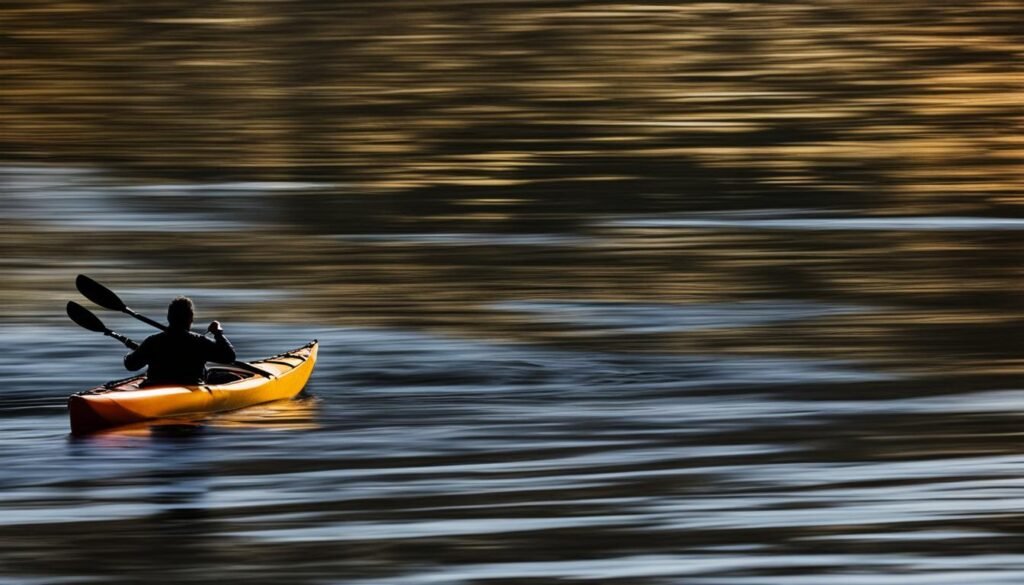
Understanding Waterways: Freshwater Versus Saltwater Tactics
Delving into the world of kayak fishing, I’ve garnered a trove of freshwater fishing tips that cater to the idyllic settings of lakes and rivers, each with their distinct fish habitats and behaviors. In the realms of freshwater, it’s pivotal to craft your strategies around the nuanced structures and flows presented by these tranquil bodies of water. To that end, let’s dive into the contrasting approaches required when navigating inland waters versus the boundless expanse of the sea.
Adapting Strategies for Lakes and Rivers
Embarking on a kayak fishing escapade in lakes and rivers, I find myself drawn to shoreline hotspots where structures such as flats and channels dominate the landscape. Navigating these freshwater waterways demands a certain finesse, incorporating an array of fishing techniques that morph with the shifting underwater terrain.
- Employing **trolling** in rivers with a steady current steers me toward success, particularly when seeking species like trout or walleye.
- The subtle strategy of **jigging** becomes my approach of choice in the deep pockets of lakes, where bass and pike often lurk.
- Leveraging the stability of my kayak, I cast near **drop-offs** where sudden depth changes create an ideal ambush zone for predatory fish.
As I refine these techniques, I’m reminded of the timeless essence of freshwater fishing; an interplay of patience and prowess that rewards the knowledgeable angler who reads the water like a seasoned navigator.
Navigating Coastal and Offshore Waters
Transitioning from the serenity of freshwater to the vastness of the ocean, my kayak becomes my vessel for inshore and offshore conquests. With saltwater’s inherently different conditions, my fishing tactics shift to adapt to the dynamic coastal environments and the behemoths that dwell within.
- In inshore areas, the art of **sight-fishing** reigns supreme, harnessing my vantage point to spot redfish amongst the shallows.
- Forays into the offshore realm necessitate stout tackle capable of subduing the likes of tuna and marlin, which command respect with their sheer power.
- Navigating the unpredictable swells and currents, I rely on heavy gear and my experience to safely land the big fish that define saltwater’s allure.
Whether it’s dissecting the briny flats for inshore treasures or braving the depths for a prized catch, the kaleidoscope of coastal and offshore waters challenges me to merge preparedness with adaptability.
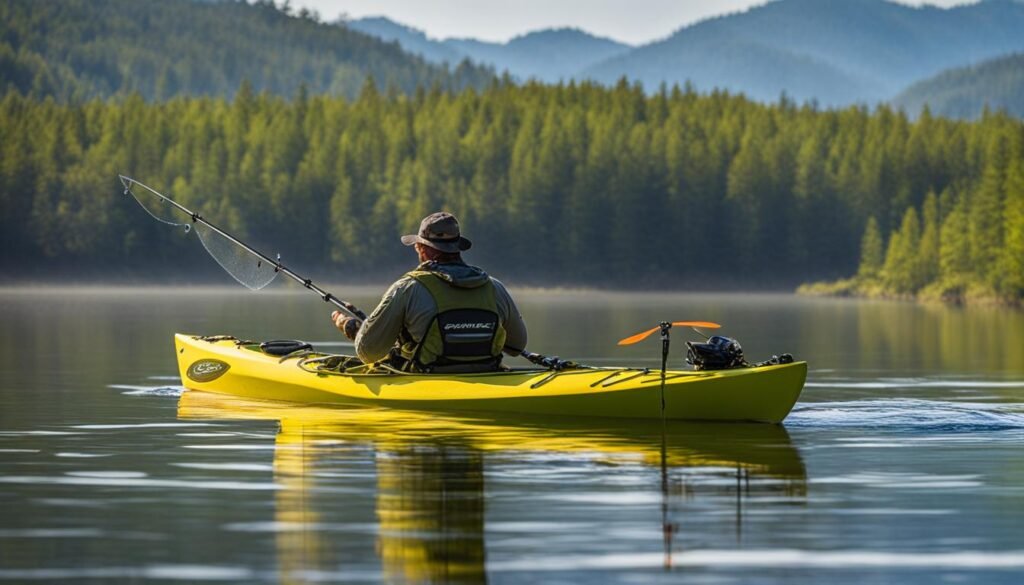
From the gentle flow of a river to the rhythmic pulse of the ocean, kayak fishing embodies the versatility and depth of angling—a pursuit where strategies and surroundings coalesce, culminating in tales of the catch. It’s an endeavor that opens chapters of immersive experiences, each penned by the stroke of a paddle and the arc of a rod.
Kayak Fishing: Combining Gear with Technique
Embarking on the kayak fishing venture, I’ve learned that the magic happens when meticulously chosen fishing accessories synergize with honed angling techniques. The right gear combination is not just about having the best tools; it’s about using them to enhance my angling prowess, a crucial element for the increased catch rate that every angler desires.
From my experience, spinning rods paired with lightweight reels are my go-to gear when precision and versatility are required. For targeting various species, I carry a range of lures, each selected for their proven ability to entice the target fish within different environments. Whether it’s a spinnerbait skimming through the shallows for bass or a deep-diving crankbait for those lunkers below, the gear must match the technique.
- Carrying a variety of lures tailored to the day’s targeted species can turn a quiet fishing trip into a trove of catches.
- Strategically using weight to present baits naturally with the water’s current earns me more bites than force-feeding the fish.
- Paying attention to subtle details like lunar phases and water temperature guides my selection of baits and presentation methods.
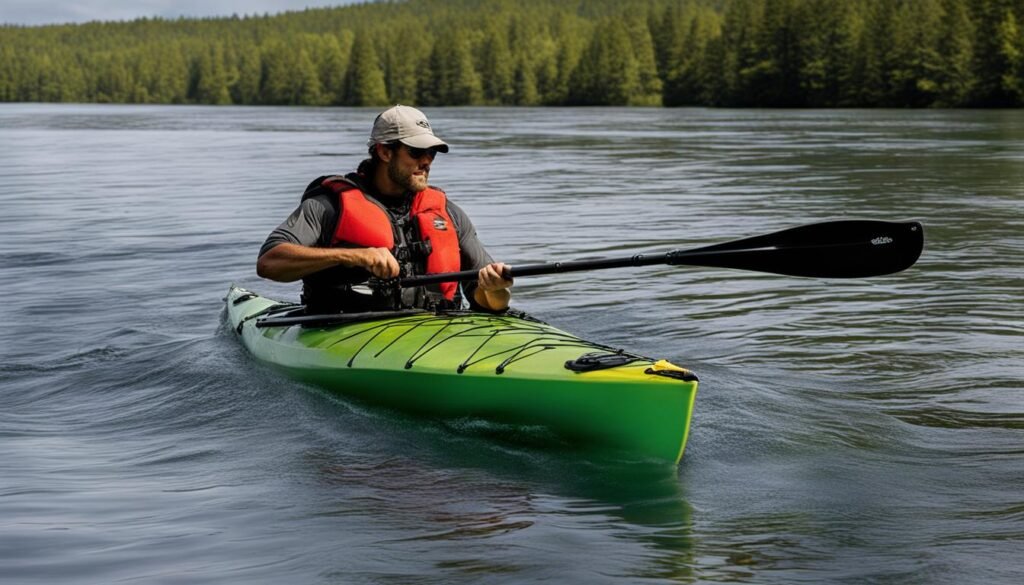
Over time, I’ve curated a fishing guide within my mind, filled with notes on tips and techniques that have proved fruitful across different waters. Here’s an abridged version of that guide:
Patience, precision, and the right gear are the holy trinity of successful kayak fishing.
This personal mantra has served as the foundation for numerous successful trips, where the harmony between gear and technique transforms potential into performance. Whether it’s a tightly-wound spinnerbait cast under a dangling tree limb or a subtle jig danced among rock beds, the art lies in the seamless blend.
One of the most valuable lessons I’ve learned—enhanced angling doesn’t always mean complexity. Sometimes, a simple rig and a well-practiced knot can outfish the most sophisticated setups. The beauty is in the balance, an equilibrium between gear and skill, where one enhances the other in the quest for the catch.
Safe Handling and Catching of Fish from a Kayak
Out on the water, the climax of my kayak fishing adventures often unfolds through the careful process of setting the hook and ultimately reeling in a big one. The artistry in a successful catch involves a choreography of smooth motions and decisive moments; a steady hand to hook, and a patient yet firm approach to guiding the fish gently onto my kayak. Let’s delve into the techniques that enhance these definitive moments of angling triumph.
Methods for Setting the Hook and Reeling In
Whether I’m angling for feisty bass in freshwater or enticing saltwater species, the technique of setting the hook is universal. Timing is everything, and as I feel the tug, I ready myself for action. My experienced grip tightens, and with a purposeful jerk, I set the hook, ensuring it pierces cleanly into the fish’s mouth, respectful yet firm—a vital move to secure my soon-to-be catch.
Reeling the fish in is no less of an art. It begins with maintaining tension on the line, a harmonious balance that neither allows the fish excess slack to escape nor too taut a line that could break. The dance is in the retrieval—reeling in, giving line when needed, and using the drag system effectively. This seamless interplay steadily coaxes my quarry to the side of my kayak.
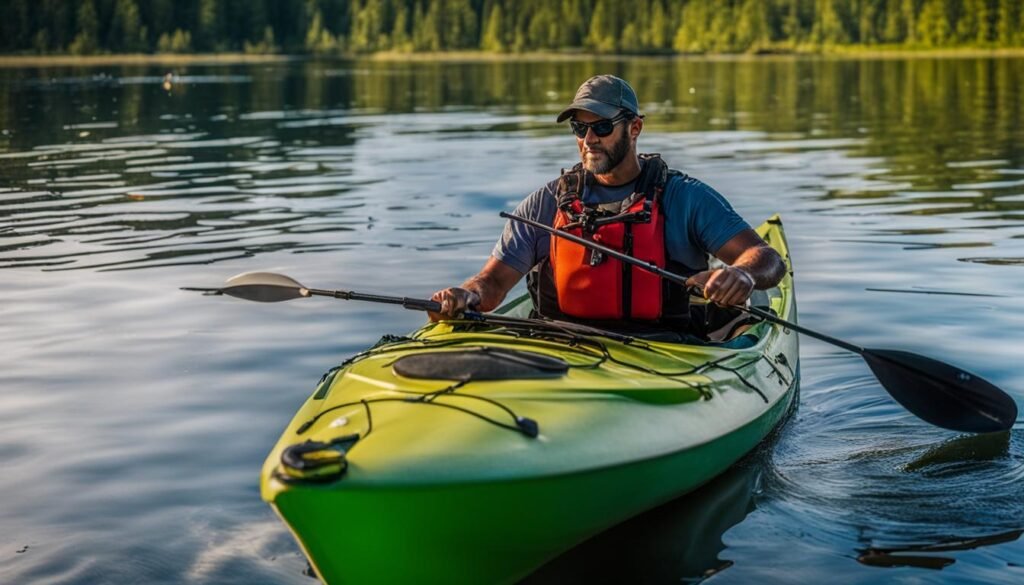
Proper Fish Storage and Preservation Techniques
Catching the fish is just part of the voyage; how I store my bounty becomes paramount for preserving the integrity of the catch, especially if the day’s haul has been generous. Onboard, I’ve come to rely on an insulated cooler, one well-prepped with ice packs, a convening place for each fish I respectfully harvest from the depths. Ensuring each catch is stored promptly minimizes spoilage and retains the freshness I cherish so much upon returning to land.
I’ve also incorporated dry bags into my kayak fishing setup. Ideal for less robust catches or those voyages where I catch and release. These bags protect not only the fish but also my gear from the elements. It is in these thoughtful measures—meticulous storage and preservation techniques—that I not only catch more fish but also honor each one through my practices.
In each outing, these aspects—precise hook setting, skilled reeling, and responsible fish management—are pivotal in my kayak fishing repertoire. They are the subtle yet vital threads that weave into the narrative of a fruitful day on the water.
Accessorizing Your Kayak for Enhanced Fishing Experience
As I prepare for a serene day of kayak fishing, I always emphasize the importance of accessorizing my kayak to boost my effectiveness on the water. The right accessories can significantly extend the functionality of your fishing kayak setup, ensuring a more productive and enjoyable experience. Let’s explore how adding mounted rod holders, customized rigging, and the best kayak life jackets not only add to the convenience but also to my safety while out angling.
Mounted Rod Holders and Customized Rigging
One aspect of kayak customization I find indispensable is the addition of mounted rod holders. The strategic placement of these holders allows me to manage multiple lines simultaneously and switch between tactics effortlessly. Combined with customized rigging, my kayak becomes a highly efficient fishing platform that adapts to the various techniques I may employ throughout the day. With this setup, I’ve seen an undeniable positive impact on my overall catch rates.
The integration of customized rigging solutions has enabled me to tailor my kayak to specific fishing scenarios. Whether it’s adding safety straps to secure gear or outfitting the kayak with additional storage, the goal is always to enhance the kayak’s functionality and my comfort. This level of customization ensures that every piece of gear has its place, keeping my deck clutter-free and my attention firmly on the fish.
Selecting PFDs and Protective Wear for Kayak Fishing
Another key consideration for me when accessorizing is selecting the right personal flotation device (PFD) and protective wear. The choice here isn’t just about compliance with safety regulations; it’s about personal comfort and mobility. The best kayak life jackets are those that offer a snug yet comfortable fit, allowing for the full range of arm motion necessary for paddling and casting.
I always equip my kayak with a PFD designed specifically for anglers, with features like breathable material and pockets for easy access to small tackle. Safety equipment such as whistles, first aid kits, and visual distress signals also accompany me on every trip, ensuring that I’m well-prepared for any situation. By taking the time to select the appropriate PFD and protective wear, I not only comply with safety standards but also enhance my angler comfort, making my fishing adventures as safe as they are enjoyable.
Pedal versus Paddle: Choosing the Right Propulsion for Your Fishing Kayak
As I consider the options to choose a kayak that best suits my fishing adventures, the decision often boils down to whether to go for a pedal drive system or a traditional paddle kayak. These are two popular means of kayak propulsion, each with distinct characteristics that offer unique benefits for angling. Let’s delve into the advantages of both and how they can impact my angling experience on the water, especially when the lure of hands-free fishing beckons, or when the rhythm of the paddle calls.
Benefits of Pedal Drives for Hands-Free Fishing
One of the most significant advantages I’ve found when using a pedal kayak is the benefit of hands-free fishing. The pedal drive system allows me to control the kayak while leaving my hands free to cast and manage my fishing line. This not only increases stability and efficiency on the water but also enhances my fishing maneuverability. While casting, reeling, or engaging in any of the intricate elements of the angling process, my feet manage the kayak’s propulsion, giving me a strategic edge.
Physical Benefits and Drawbacks of Traditional Paddling
Contemplating the use of a traditional paddle kayak, I’m reminded of the simplicity and the intimate connection it allows with the water. The silent glide of the paddle slicing through the surface offers me a physical workout and a sense of harmony with the environment. However, the need to periodically switch between the paddle and the fishing rod can be viewed as a drawback. The reality that I may need to pause my fishing to navigate is an important consideration, especially when I plan my trip on busier waterways or when the fish are particularly active, making the number 12 in the school a challenging catch.
Appreciating the art of paddling, I recognize that this traditional method of kayak propulsion can be more physically demanding and less convenient for fishing compared to pedal drive systems. However, the quietness and environmentally friendly nature of paddle kayaks can offer a meditative fishing experience, fostering an even deeper connection with the outdoor environment I cherish with each stroke.
Launching Your Kayak: Tips for a Smooth Start
Embarking on a kayak fishing adventure begins with the foundational step of launching your kayak. I’ve learned that achieving a smooth start is pivotal for setting the tone of the day. Whether you plan to fish in serene lake waters or venture into flowing rivers, starting off on the right paddle stroke is key. Here are my time-tested tips for beginners and seasoned kayakers alike that ensure portability and ease from the moment your kayak touches the water.
Firstly, always check weather conditions before leaving shore. Unexpected winds and currents can turn a day of fishing into an arduous task. As a kayaker, understanding the day’s forecast helps me to prepare both mentally and logistically for the waters ahead.
- Review local weather reports for wind, tides, and storm advisories.
- Select a launch site with easy access and safe exit points into the water.
- Prepare your kayak – ensure all gear is securely fastened and essentials within reach.
Next, a pre-launch checklist is essential to avoid any mid-water mishaps. I make sure my kayak is loaded with all necessary equipment, with personal safety gear at the forefront. Life jackets, whistles, and a basic first aid kit are non-negotiable items for my excursions.
| Item | Description | Importance |
|---|---|---|
| Personal Floatation Device (PFD) | USCG-approved life jacket | Crucial for safety |
| Waterproof Container | To protect electronics and valuables | Protects against water damage |
| Emergency Whistle | Audible signaling device | For calling attention in case of emergency |
| First Aid Kit | Basic medical supplies for minor injuries | Essential for handling unexpected injuries |
Understanding the technique for launching a kayak is another crucial step. A proper launch not only gets me started quickly but also conserves my energy for the fishing ahead:
- Position the kayak perpendicular to the shoreline.
- Stabilize the kayak with your paddle as you board.
- Use your hands and paddle to push off into the water.
- Adjust your seating and ensure all gear is within reach before paddling away.
The portability of a kayak is one of its greatest benefits, allowing me to access remote and undisturbed fishing spots. With careful planning and attention to the basics, even a novice kayaker can experience a seamless start to a day of aquatic exploration and hopefully, a bountiful catch.
Environmental Stewardship and Ethical Angling Practices
As a kayak angler, I have always believed that the stewardship of our aquatic environments is as integral to the sport as the thrill of the catch itself. Recognizing that every action we take has a palpable impact on the waterways, I have committed myself to ethical angling practices that ensure the sustainability of our beloved aquatic habitats.
Understanding Catch and Release Principles
The practice of catch and release is more than a technique; it’s a cornerstone of environmental conservation. By following established guidelines to minimize harm, I am able to enjoy the sport of fishing while making a conscious effort to maintain healthy fish populations. Proper handling methods during capture and release ensure that fish have the best chance at survival post-release, strengthening the ecosystem of which they are a part.
The Importance of Preserving Aquatic Habitats
In my journey as a kayak fisherman, I have witnessed firsthand the critical role that healthy aquatic ecosystems play in the quality of our angling experiences. For these reasons, I am mindful of my responsibility toward environmental stewardship and the preservation of aquatic habitats. This includes proper disposal of fishing line, avoiding disturbances to vegetation and wildlife, and contributing to local conservation efforts that aim to protect and restore the natural habitats within our waterways.
- Adherence to catch and release guidelines to promote sustainable angling
- Engagement in habitat preservation activities
- Participation in clean-up drives to remove debris from waterways
- Support for local and national conservation policies
- Educating fellow anglers about responsible fishing practices
I know that ethical angling and environmental stewardship are inseparable from the legacy of fishing. By upholding these practices, we safeguard the future of our sport and ensure that future generations can enjoy the same pristine waters and thrilling encounters with fish that we do today. As I reflect on the importance of these matters, I’m reminded of the thoughtful words of environmentalist Aldo Leopold, “We can only be ethical in relation to something we can see, feel, understand, love, or otherwise have faith in.”
Seasonal Fishing Patterns and Kayak Angling
As a dedicated kayak angler, I’ve quickly learned that grasping the seasonal fishing patterns is not just helpful—it’s fundamental to crafting a successful outing. Over the years, my logs have become rich with notes on fish behavior, noting how the change of seasons influences the movements and feeding habits of various species. It’s this knowledge that informs me when to plan my fishing trips, ensuring I’m hitting the water when conditions are ripe for action.
Spring, with its warming waters, draws fish into shallower areas to spawn, presenting an opportunity for exceptional catches. As I switch to summer, I target deeper waters, finding fish escaping the heat. Come fall, the cooling water triggers fish to feed heavily before winter, leading to some thrilling kayak angling experiences. Finally, winter presents its own quiet beauty, though it requires perseverance and patience as fish slow down and become less active.
Knowing the best fishing times isn’t just about the season, but also the time of day. Dawn and dusk often become the magical hours when fish are most active, providing a serene backdrop to the excitement of the chase. Let’s break down a typical year on the water, offering a glimpse into an angler’s seasonal calendar:
| Season | Species Targeted | Preferred Habitat | Recommended Technique |
|---|---|---|---|
| Spring | Bass, Trout | Shallows, Spawning Beds | Sight-Fishing, Fly Fishing |
| Summer | Catfish, Walleye | Deep Structures, Cooler Water | Trolling, Jigging |
| Fall | Pike, Perch | Transitional Areas, Drop-offs | Casting Crankbaits, Spinnerbaits |
| Winter | Crappie, Bluegill | Deep Pools, Near Thermoclines | Vertical Jigging, Slow Retrieval |
Recognizing these patterns has led me to appreciate the rhythm of nature and to become a more intuitive angler. I plan my kayak angling seasons with great anticipation, each presenting new challenges and opportunities. Realigning my techniques with the shifting seasons, I adapt, evolve, and grow as an angler.
When considering the profound influence of seasons on fish behavior, my time spent in the kayak has transformed from purely recreational to deeply educational. To fellow anglers, I say: tune into the seasons, study the cycles, and you’ll find yourself at the right place at the right time, rod bent and reel singing, in the dance of kayak angling.
Top Fishing Destinations for Kayak Anglers
As someone who has cast lines in waters far and wide, I find there’s an indescribable charm to kayak fishing in the diverse ecosystems found in this great country. The pursuit of the perfect fishing spot is ever-evolving, yet some destinations continue to draw me back with their abundant offerings and breathtaking vistas. Let’s delve into the revered locales that beckon kayak anglers to their tranquil and bountiful waters.
Exploring Inland Lakes and River Systems
When it comes to serene fishing getaways, inland lakes and river systems are unparalleled. These freshwaters, so vibrant in aquatic life, have consistently ranked as top kayak fishing destinations. Whether you’re navigating the placid waters of a secluded lake or the gentle currents of a meandering river, the presence of flourishing fish populations and the calming connection with nature make for an unrivaled angling experience.
Each visit to these freshwater venues presents a chance to reel in species such as largemouth bass, crappie, and northern pike. The accessibility of these inland lakes and river systems often means that the treasured fishing spots are but a short paddle away, making them ideal for both spontaneous day trips and planned excursions alike.
Venturing Into Open Water: Coastal and Ocean Fishing
Then there’s the invigorating challenge of coastal and ocean kayak angling. As I thrust my kayak into the open water, the thrill of pursuing larger game sets in. Saltwater destinations have a way of amplifying the kayak fishing experience with the opportunity to engage with formidable adversaries such as tarpon, tuna, and even sharks.
The unparalleled open water experiences found in coastal and ocean environments come with their own set of considerations. Balancing the excitement with the unpredictable nature of the sea is essential, making the preparation of safety and specialized gear a top priority. Navigating these saltwater locales often serves as a testament to an angler’s skill and adaptability, rewarding the prepared with tales of majestic catches and deep-sea victories.
In the pursuit of these coastal and ocean giants, the number 16 signifies more than a tally of fish; it embodies the culmination of skill, patience, and the profound respect we as anglers hold for the might of the sea.
So whether it’s the peaceful journey amidst the reeds of an inland lake or the vigor of battling the surf’s surge, these cherished kayak fishing destinations collectively weave the tapestry of an angler’s dream. With every stroke of the paddle and flick of the rod, we’re reminded of the simple joy that kayak fishing brings to the soul.
Kayak Fishing Lessons and Resources
The current digital age allows us to expand our horizons and enhance our hobbies with a wealth of knowledge at our fingertips. For enthusiasts keen on refining their reel, kayak fishing lessons and angler education available online boast a range of resources that significantly improve fishing skills. From experienced charters sharing their wisdom to communities of anglers exchanging tips, the online space offers a multitude of ways to nurture our passion for fishing. Below, I’ll detail some of the valuable resources that have contributed to my growth as a kayak fisherman.
Embarking on the journey of improving my fishing skills, I discovered various online resources that cater specifically to the unique nuances of kayak fishing. Here’s a look at some of them:
- Video Tutorials and Webinars: Platforms like YouTube have channels dedicated to kayak fishing where professionals teach about the correct paddling techniques, lure selection, and casting methods.
- Virtual Workshops and Clinics: Many fishing gear brands and local bait shops offer webinars and virtual classes, allowing me to learn from experts without having to leave my home.
- Online Forums and Communities: Participating in online forums has been a great way to connect with other kayak anglers, ask questions, and get tips on local fishing spots, as well as feedback on gear and techniques.
For those who thrive not just in the virtual classroom, but also through hands-on learning, local workshops and guided tours provide practical experiences:
- Local Workshops: I’ve attended workshops held by outdoor retailers and local fishing clubs that offer on-site teachings about kayak safety, fishing techniques, and local regulations.
- Guided Tours: Perhaps one of the best ways to learn has been joining guided fishing tours. These guided excursions allow me to watch and learn from the pros in real-time, picking up on tacit knowledge that isn’t always communicated in manuals or videos.
Additionally, I’ve compiled resources in a simple table to help fellow anglers find the aid they need to enhance their angling education:
| Resource Type | Description | Best For |
|---|---|---|
| Interactive Online Courses | Structured curriculum with a mix of video, articles, and quizzes | Anglers who prefer a structured learning path |
| Social Media Groups | Platforms for anglers to share experiences, advice, and support | Building community and crowdsourcing advice |
| One-on-One Remote Coaching | Personalized instruction from experienced guides | Anglers seeking targeted improvement |
| E-books and Blogs | Digital books and articles written by seasoned kayak fishermen | A deep dive into specific topics |
My endeavor to improve fishing skills has been enriched by these resources, but the journey doesn’t end here. Continuous learning and staying updated with kayak fishing lessons propel us to become more adept anglers, enjoying the sport safely, responsibly, and with a great deal of success. Ultimately, it’s about blending the time-honored wisdom of our predecessors with the dynamic tools of today to create lifelong memories out on the water.
Conclusion
Kayak fishing is a journey—a confluence of adventure, patience, and learning that reflects the essence of angling. Every kayak fishing trip offers us a glimpse into nature’s serenity and an opportunity to bond with its rhythm. This guide to kayak fishing has been a comprehensive repository of insights that illuminate the path for both fledgling and veteran anglers aiming to improve their angling experience.
From gear selection that marries function with ergonomics, to techniques that spell success beneath the waves, this guide has aimed to impar knowledge that primes you for the rewarding challenge that lies ahead. As you cast your line and paddle through diverse waterways, the information provided herein is designed to enhance your skills and ensure your experiences are enriching and fruitful.
As you set forth on your next or maybe even your inaugural kayak fishing venture, carry these learnings like a seasoned mariner’s compass. Let the lessons of environmental stewardship serve as a reminder to preserve the splendor that hosts our sporting passions. With every cast and every glide, may your experiences on the water not only echo with the success of the catch but also resonate with the treasures of insights gained. The ultimate guide to kayak fishing has been charted—the rest of the tale is yours to write.
FAQ
What do I need to consider when choosing a fishing kayak?
When selecting a fishing kayak, consider your intended fishing environments, the kayak’s stability, the amount of storage space you’ll need, its weight capacity, and whether a sit-on-top or sit-in kayak best suits your needs. You may also want to decide between a paddle or pedal drive system based on your fishing style.
How do I outfit my kayak for an optimal angling experience?
Outfit your kayak with essential gear like adjustable rod holders, a tackle box, bait storage, and fishing rod attachments. Consider integrating advanced technology such as a fish finder to enhance your angling experience. Ensure you have ample deck space and secure storage for your equipment.
Can you give me some kayak fishing techniques?
Master the art of stealth to approach fish without startling them and perfect your casting technique to reach optimal locations. Jigging and trolling are effective strategies to vary your approach, increasing your chances of catching fish. Adjust your techniques based on whether you’re fishing in fresh or saltwater.
What is the difference between pedal and paddle kayaks for fishing?
Pedal kayaks allow for hands-free fishing and control, letting you focus on handling your rod and reel. They generally provide greater stability and fishing efficiency. Paddle kayaks require manual navigation and can be quieter, offering a physical workout but may limit your fishing activity while on the move.
How do I properly handle and store fish caught from my kayak?
Once you’ve hooked and reeled in the fish, gently secure it with a net and transfer it to an onboard cooler or storage compartment designed to keep the catch fresh. It’s essential to handle the fish carefully to maintain the meat’s quality or to release it unharmed if you’re practicing catch and release.
What are some best practices for launching my kayak?
Before launching, check the weather conditions, and ensure all your gear and safety equipment are properly secured. Familiarize yourself with the launching techniques suitable for your location and maintain a pre-launch checklist to ensure you don’t forget any essential items.
Why is environmental stewardship important in kayak fishing?
Kayak anglers have a responsibility to protect and preserve aquatic habitats. This includes practicing ethical angling, like catch and release, and minimizing environmental impact by disposing of fishing line properly and avoiding disturbances to the ecosystem. Doing so helps maintain fish populations and the overall health of our waterways.
What should I know about fishing in different seasons?
Understand that fish behavior and ideal fishing conditions change with the seasons. Knowing which species are active and when can help you plan trips that align with seasonal migrations and spawning periods. Seasonal patterns will influence the timing of your fishing excursions and your strategy on the water.
Where can I find resources to improve my kayak fishing skills?
You can improve your kayak fishing skills through online courses, local angler workshops, fishing guides, and even by hiring professional tours for hands-on learning. These resources are invaluable for picking up new techniques, learning about gear, and becoming part of the kayak fishing community.
